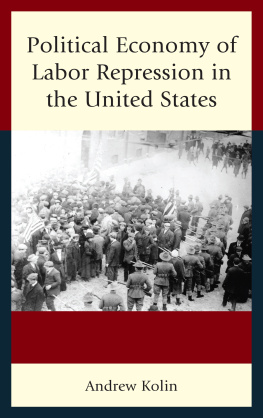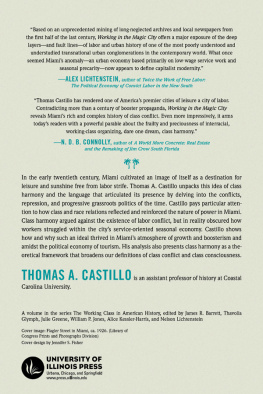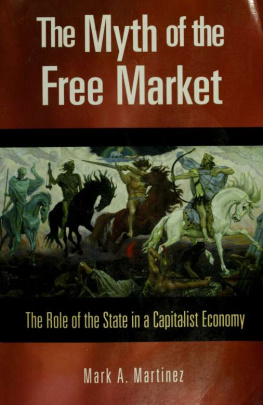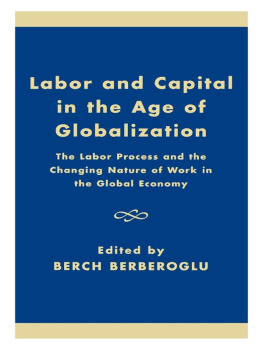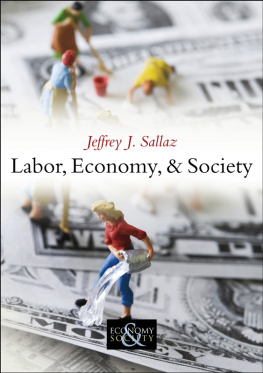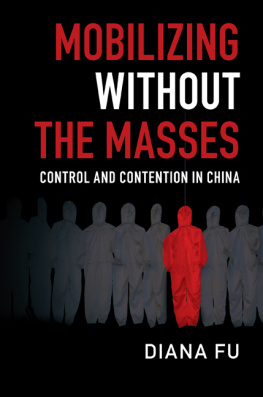Kolin - Political economy of labor repression in the United States
Here you can read online Kolin - Political economy of labor repression in the United States full text of the book (entire story) in english for free. Download pdf and epub, get meaning, cover and reviews about this ebook. City: United States., year: 2017, publisher: Lexington Books, genre: Politics. Description of the work, (preface) as well as reviews are available. Best literature library LitArk.com created for fans of good reading and offers a wide selection of genres:
Romance novel
Science fiction
Adventure
Detective
Science
History
Home and family
Prose
Art
Politics
Computer
Non-fiction
Religion
Business
Children
Humor
Choose a favorite category and find really read worthwhile books. Enjoy immersion in the world of imagination, feel the emotions of the characters or learn something new for yourself, make an fascinating discovery.
Political economy of labor repression in the United States: summary, description and annotation
We offer to read an annotation, description, summary or preface (depends on what the author of the book "Political economy of labor repression in the United States" wrote himself). If you haven't found the necessary information about the book — write in the comments, we will try to find it.
Kolin: author's other books
Who wrote Political economy of labor repression in the United States? Find out the surname, the name of the author of the book and a list of all author's works by series.
Political economy of labor repression in the United States — read online for free the complete book (whole text) full work
Below is the text of the book, divided by pages. System saving the place of the last page read, allows you to conveniently read the book "Political economy of labor repression in the United States" online for free, without having to search again every time where you left off. Put a bookmark, and you can go to the page where you finished reading at any time.
Font size:
Interval:
Bookmark:
Political Economy of Labor
Repression in the United States
Political Economy of Labor
Repression in the United States
Andrew Kolin
LEXINGTON BOOKS
Lanham Boulder New York London
Published by Lexington Books
An imprint of The Rowman & Littlefield Publishing Group, Inc.
4501 Forbes Boulevard, Suite 200, Lanham, Maryland 20706
www.rowman.com
Unit A, Whitacre Mews, 26-34 Stannary Street, London SE11 4AB
Copyright 2017 by Lexington Books
All rights reserved. No part of this book may be reproduced in any form or by any electronic or mechanical means, including information storage and retrieval systems, without written permission from the publisher, except by a reviewer who may quote passages in a review.
British Library Cataloguing in Publication Information Available
Library of Congress Cataloging-in-Publication Data
Names: Kolin, Andrew, 1955- author.
Title: Political economy of labor repression in the United States / Andrew Kolin.
Description: Lanham : Lexington Books, [2017] | Includes bibliographical references and index.
Identifiers: LCCN 2016034878 (print) | LCCN 2016048042 (ebook) | ISBN 9781498524025 (cloth : alk. paper) | ISBN 9781498524032 (electronic)
Subjects: LCSH: LaborUnited StatesHistory. | Labor unionsUnited StatesHistory. | Labor policyUnited StatesHistory.
Classification: LCC HD8066 .K65 2017 (print) | LCC HD8066 (ebook) | DDC 331.10973dc23
LC record available at https://lccn.loc.gov/2016034878
 TM The paper used in this publication meets the minimum requirements of American National Standard for Information Sciences Permanence of Paper for Printed Library Materials, ANSI/NISO Z39.48-1992.
TM The paper used in this publication meets the minimum requirements of American National Standard for Information Sciences Permanence of Paper for Printed Library Materials, ANSI/NISO Z39.48-1992.
Printed in the United States of America
To my parents, Helene Kolinoffice worker/supervisorand Morris Kolinpostal service letter carrierfor instilling an understanding of working class consciousness.
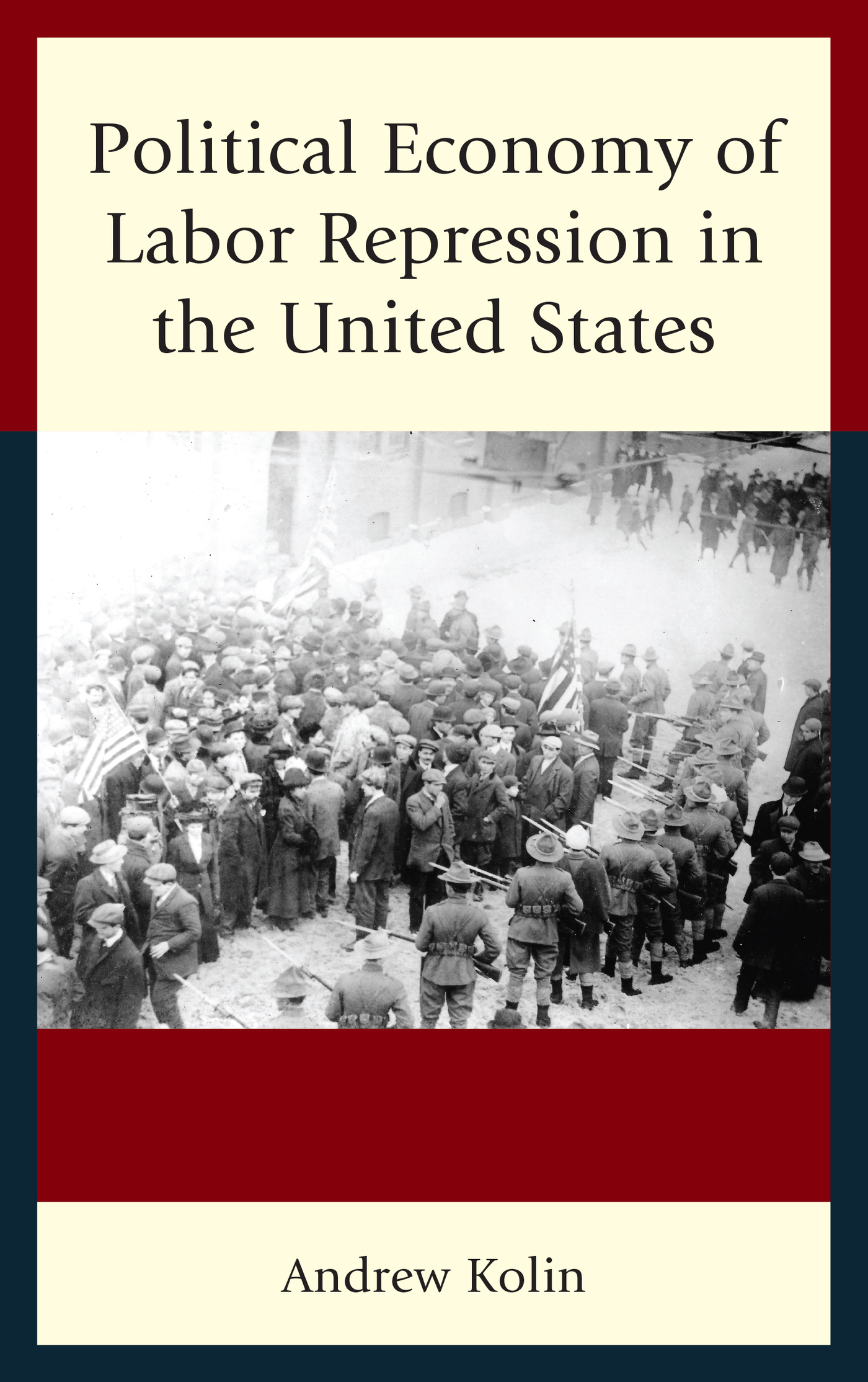
I would like to thank the staff of Lexington Books, in particular, the politics editor Kathryn Tafelski for her professionalism and attentiveness to the revisions of the manuscript. In addition, I appreciate the assistance and detailed orientation of the production team members, Madhumitha Koduvalli and Megan DeLancey. Above all, and most important, I am grateful for the support, dedication, and editing by my wife, Ellen, who no doubt made this book possible.
In writing State Power and Democracy: Before and During the Presidency of George W. Bush (2012), my goal was to examine the political history of repression, which limited mass democracy and led to an authoritarian state. The discussion of repression in that book was confined to an analysis of policymaking. What was omitted from that discussion was how to relate repression to the state and the economy and any reference to how political and economic elites were aligned to repress labor. My goal with this book is to view repression as an expression of a class struggle between capital and labor.
The task at hand is to place the political economy of repression within the contours of U.S. history. It involves sketching in broad terms how, over time, repression is the product of dynamic and fixed relations between capital and labor. The goal is to represent how capital is able to repress labor given essential prerequisites. By identifying how capital and labor interact, it is possible to outline the main features of repression. The intent is not to write a comprehensive history of capital-labor relations, instead it is to select specific points in time that best illustrate how capital represses labor. While this book makes use of important histories of labor, these histories do not address the books central themes, how a political economy of repression is produced and reproduced within institutional frameworks often overlooked in standard histories of labor.
Labor historians often overlook how capital-labor interactions are structured in terms of the production and reproduction of repression, ignoring the bases of repression, grounded in and expressed through institutional exclusion. They also overlook how labor repression can be overcome due to the contradictory nature inherent in a political economy of repression. The first step in outlining the possible liberation of labor from a political economy of repression is to consider the historical conditions that produce the repression of labor in the United States.
There are notable exceptions to this neglect of class relations in the context of institutional arrangements. This books emphasis is on key historical moments that illustrate how labor repression developed in terms of two key variables: first, a dependent variable that operates as institutional exclusion as capital assumes and works to maintain control over the state and the economy, and second, an independent variable, in key historical moments where one can measure the intent of labor repression in terms of the rise and fall of American capitalism.
The dependent variable appearing as institutional exclusion generates various forms of covert repression. For the repression to be covert, it would be built into the functions of the state and the economy in which capital has achieved hegemony. This dependent variable of institutional exclusion occurs as capital achieves a monopoly of ownership over the means of production. In so doing, ownership serves to legitimate the use of covert repression of labor in the workplace. In addition, excluding labor from a primary role as a decision-maker in the state results from elite ownership of state power, which in turn, justifies policies and actions, which re-create the oppression of labor. Frequently omitted from labor histories is this dual institutional exclusion, which makes it possible for elites to monopolize the resources of power, and in so doing, dominate labor. Expressions of overt repression, such as degrees of force and violence operating outside institutional frameworks, are the most visible forms of social control of labor.
Specific events dictate the usefulness of covert and overt repression. In comparing the present to the past, capital has been successful in utilizing with a greater degree of effectiveness covert rather than overt repression, especially in the latter part of the twentieth century and the start of the twenty-first century. A qualification in assessing the use of covert and overt repression is the extent to which labor acknowledges its institutional exclusion, seeking to organize labor so as to be in a better position to achieve limited demands. This means that capital-labor relations and repression are not a zero-sum game. Capital and labor both understand at times the necessity of forging alliances. In specific historical moments, capitalists understand it is to their advantage to seek collective agreements with labor as a means of economizing the use of repression. For labor, it is not a matter of choice. Organized labor seeks inclusion, it seeks to collaborate in order to acquire short-term gains. Having achieved institutional exclusion from decision-making, capital maintains the upper hand in framing collaboration to its own advantage. Whether capital-labor engages in collaboration or labor segments engage in outright conflict in open antagonism is often determined by the economic cycles of American capitalism.
This is not to say there are no limits to labor repression expressed as collaboration and conflict between capital and labor. The inherent contradictions in how capital seeks to repress labor present possible alternatives. To identify alternatives to labor repression is to identify the built-in limitations inherent in a political economy of repression, thus identifying how labor would liberate itself from the dictates of capital. Discussing how labor could create economic and political democracy can include an examination of why repression is essentially self-destructive. Repression of labor by capital contains the seeds of its own destruction. Since the various means utilized to repress labor always out of necessity have to be reproduced, in this process of reproduction, the repression is never finalized and complete. In reproducing repression, labor, in combination with the appropriate historical circumstances, can work toward its liberation. So while the goal is to describe the production and reproduction of labor repression, such repression is always in contradiction to the social needs of labor, that is, the liberation of labor from the domination of capital. This inherent possibility of labors liberation is built into the limits of a political economy of repression. A detailed presentation of labor repression appears in the individual chapters. Below, are brief summaries of each chapter.
Next pageFont size:
Interval:
Bookmark:
Similar books «Political economy of labor repression in the United States»
Look at similar books to Political economy of labor repression in the United States. We have selected literature similar in name and meaning in the hope of providing readers with more options to find new, interesting, not yet read works.
Discussion, reviews of the book Political economy of labor repression in the United States and just readers' own opinions. Leave your comments, write what you think about the work, its meaning or the main characters. Specify what exactly you liked and what you didn't like, and why you think so.

